Pheidole hortensis
| Pheidole hortensis | |
|---|---|

| |
| Scientific classification | |
| Kingdom: | Animalia |
| Phylum: | Arthropoda |
| Class: | Insecta |
| Order: | Hymenoptera |
| Family: | Formicidae |
| Subfamily: | Myrmicinae |
| Tribe: | Attini |
| Genus: | Pheidole |
| Species: | P. hortensis |
| Binomial name | |
| Pheidole hortensis Forel, 1913 | |
This species inhabits not only well-developed forests but also drier and shrubby vegetation. The species usually nests in rotting twigs and wood blocks on the ground, and stores up a number of tiny seeds in its nest (Eg96-BOR-062; Eg97-BOR-378, 448, 470). I have never encountered colonies containing more than one dealate queen. (Eguchi 2001)
Identification
Eguchi (2001) - P. hortensis is closely related to Pheidole maculifrons, Pheidole tenebricosa, Pheidole clypeocornis, Pheidole kikutai and Pheidole rugifera. All these are well recognisable among Indo-Chinese and Indo-Malayan congeners in having the following exceptional characteristics: masticatory margin of mandible bearing two denticles just in front of basal angle in the major (this condition is seen in only Pheidole fantasia except the above six species); ventral faces of midcoxa and hindcoxa distinctly reticulate (this condition is seen in only Pheidole aristotelis except the above six species). The following characteristics are also shared among the six species: frontal carina of the major horizontal, and (narrowly) overhanging antennal scrobe; hypostoma of the major bearing a median process. P. maculifrons is easily distinguished from the other five species collected from Borneo by having frons very weakly rugose longitudinally, vertex almost smooth and shining, dorsum of occipital lobe weakly reticulate, and alitrunk smooth and shining (one syntype major of P. maculifrons, labelled as “Holotype, MCZ, 22884”, was examined; close relationship between P. hortensis and P. maculifrons has already been suggested in Wheeler's original description). P. hortensis is distinguished from remainder of the five Bornean species as follows: in P. tenebricosa head and alitrunk of the minor punctured; in P. clypeocorniseach lateral part of clypeus of the major developed into a horn; in P. kikutai occipital carina of the minor complete; in P. rugifera head and alitrunk of the minor punctured, and outer face of mandible of the major with rugulae which run from its base toward masticatory margin.
Keys including this Species
- Key to Pheidole majors and minors of Borneo
- Key to Pheidole majors of Borneo
- Key to Pheidole minors of Borneo
Distribution
Latitudinal Distribution Pattern
Latitudinal Range: 4.594166667° to -7.709722°.
| North Temperate |
North Subtropical |
Tropical | South Subtropical |
South Temperate |
- Source: AntMaps
Distribution based on Regional Taxon Lists
Indo-Australian Region: Borneo, Indonesia (type locality), Malaysia, Philippines, Singapore.
Oriental Region: Thailand.
Distribution based on AntMaps
Distribution based on AntWeb specimens
Check data from AntWeb
Countries Occupied
| Number of countries occupied by this species based on AntWiki Regional Taxon Lists. In general, fewer countries occupied indicates a narrower range, while more countries indicates a more widespread species. |

|
Estimated Abundance
| Relative abundance based on number of AntMaps records per species (this species within the purple bar). Fewer records (to the left) indicates a less abundant/encountered species while more records (to the right) indicates more abundant/encountered species. |

|
Biology
Castes
Worker
Minor
Images from AntWeb
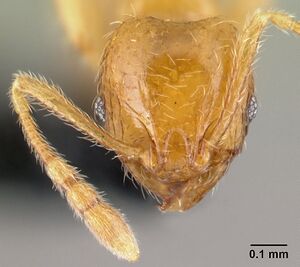   
| |
| Worker. Specimen code casent0179655. Photographer Noel Tawatao, uploaded by California Academy of Sciences. | Owned by CAS, San Francisco, CA, USA. |
  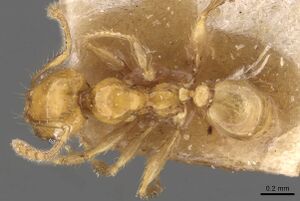 
| |
| Syntype of Pheidole hortensis. Worker. Specimen code casent0907976. Photographer Will Ericson, uploaded by California Academy of Sciences. | Owned by MHNG, Geneva, Switzerland. |
   
| |
| Syntype of Pheidole hortensis. Worker. Specimen code casent0904272. Photographer Z. Lieberman, uploaded by California Academy of Sciences. | Owned by MSNG, Genoa, Italy. |
  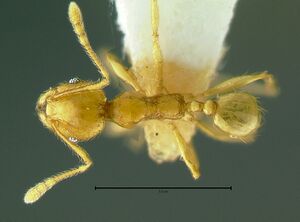
| |
| . | |
Major
Images from AntWeb
   
| |
| Worker (major/soldier). Specimen code casent0281723. Photographer Estella Ortega, uploaded by California Academy of Sciences. | Owned by NHMUK, London, UK. |
   
| |
| Worker. Specimen code casent0281724. Photographer Estella Ortega, uploaded by California Academy of Sciences. | Owned by NHMUK, London, UK. |
   
| |
| Syntype of Pheidole hortensis. Worker (major/soldier). Specimen code casent0904271. Photographer Z. Lieberman, uploaded by California Academy of Sciences. | Owned by MSNG, Genoa, Italy. |
   
| |
| Syntype of Pheidole hortensis. Worker (major/soldier). Specimen code casent0907975. Photographer Will Ericson, uploaded by California Academy of Sciences. | Owned by MHNG, Geneva, Switzerland. |
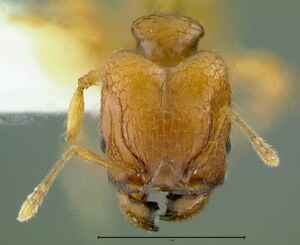  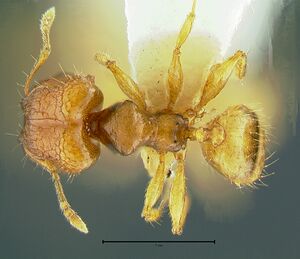
| |
| . | |
Nomenclature
The following information is derived from Barry Bolton's Online Catalogue of the Ants of the World.
- hortensis. Pheidole hortensis Forel, 1913k: 38, fig. J (s.w.q.m.) INDONESIA (Java). Imai, Kubota, et al. 1985: 47 (k.). See also: Eguchi, 2001b: 61.
Type Material
Eguchi (2001) - Major, minor, queen and male (Musee d'Histoire Naturelle Genève). Type locality: Java. Nine syntypes (2 majors, 3 minors, 1 queen and 3 males) were examined. Unless otherwise noted the text for the remainder of this section is reported from the publication that includes the original description.
Description
Worker
Eguchi (2001) - Major (n=9): TL 1.8-2.6 mm, HL 0.87-1.15 mm, HW 0.77-1.05 mm, SL 0.38-0.48 mm, FL 0.46-0.62 mm, CI 85-95, SI 45-53, FI 55-63. Head broadest at about 3/5-2/3 distance of head (as measured from the mid-point of a transverse line spanning the anteriormost and posteriormost projecting points, respectively) (Fig. 20A), in profile weakly impressed on vertex (Fig. 20B). Hypostoma bearing a median process, which is sometimes much reduced compared with the process just mesal to each mandibular insertion (arrows in Fig. 20C). Clypeus without a median longitudinal carina, with anterior margin very weakly concave medially; each lateral part of clypeus weakly produced dorsally, but not well developed into a horn as seen in P. clypeocornis sp. nov. Eye situated at about 1/3 distance of head; distance between mandibular insertion and anterior margin of eye 1.5-1.8 times as long as maximal diameter of eye. Frontal carina horizontal, extending backward to about 3/5~2/3 distance of head (Fig. 20A). Antennal scrobe narrowly overhung by frontal carina. Antenna with 3-segmented club; antennal scape extending backward to ½-3/5 distance of head; terminal segment 1.1-1.3 times as long as preceding two segments together. Masticatory margin of mandible with apical and preapical teeth, and two denticles in front of basal angle. Promesonotum forming a high dome, without a distinct prominence on its posterior declivity (Fig. 20E); each dorsolateral portion of the dome roundly and strongly produced outward (Fig. 20D). Mesopleuron divided by a weak transverse impression into upper and lower parts. Propodeal spine triangular or elongate-triangular, 1.5-2 times as long as diameter of propodeal spiracle. Petiole 1.6-1.8 times as long as postpetiole (excluding helcium); petiolar node in posterior view not, or slightly, emarginate at apex. Postpetiole 1.5-1.8 times as broad as petiolar node.
Dorsum of head excluding occipital lobe longitudinally rugose, with interspaces smooth and shining (rarely punctured very weakly); dorsal and dorsolateral faces of occipital lobe reticulate, with enclosures smooth and shining (rarely punctured very weakly); outer face of mandible rugose only laterally near its base; dorsum of promesonotal dome smooth and shining with several transverse rugulae; upper part of mesopleuron weakly punctured; lower part of mesopleuron smooth and shining; propodeum smooth and shining, or weakly punctured in part; ventral faces of midcoxa and hindcoxa distinctly reticulate over the surface; lateral face of petiole slightly punctured; dorsum of petiole, and postpetiole and gaster smooth and shining. Outer face of mandible sparsely covered with very short appressed hairs ( < 0.03 mm in length), which are (much) shorter than distance between piligerous punctures; submarginal zone of masticatory margin of mandible with a row of longer appressed hairs. Body yellowish-brown, reddish-brown or brown, with darker mandibles, clypeus and gaster (sometimes promesonotum also darker), or blackish-brown with lighter mandibles, waist and gaster; legs a little lighter than alitrunk.
Minor Measurements and indices (n=9): TL 1.3-1.7 mm, HL 0.41-0.50 mm, HW 0.39-0.48 mm, SL 0.35-0.47 mm, AL 0.52-0.65 mm, FL 0.36-0.48 mm, CI 93-97, SI 91-103, FI 92-101. Head in full-face view almost flat posteriorly (Fig. 20F); occipital carina almost absent dorsally on head. Clypeus without a median longitudinal carina, with anterior margin in full-face view slightly convex or truncate medially. Eye situated just in front of midlength of head; distance between mandibular insertion and anterior margin of eye 0.7-0.8 times as long as maximal diameter of eye. Frontal carina rarely present as an evanescent rugula extending beyond midlength of head. Antennal scrobe present only around antennal insertion. Antenna with 3-segmented club; scape extending beyond posterior border of head by its 1/5 length; terminal segment 1.1-1.2 times as long as preceding two segments together. Promesonotal dome without any prominence on its posterior declivity (Fig. 20G). Mesopleuron sometimes with an inconspicuous transverse impression. Propodeal spine ca. 1.5 times as long as diameter of propodeal spiracle. Petiole 1.5-1.6 times as long as postpetiole (excluding helcium); petiolar node in posterior view not emarginate at apex. Postpetiole ca. 1.7 times as broad as petiolar node.
Clypeus smooth and shining; remainder of head largely smooth and shining, or weakly rugosoreticulate between eye and antennal insertion; promesonotum smooth and shining; remainder of alitrunk punctured at least partly; lateral face of petiole weakly punctured; dorsum of petiole, and postpetiole and gaster smooth and shining. Body light yellowish-brown, yellowish-brown or light brown, sometimes with a little darker head and gaster.
Karyotype
- See additional details at the Ant Chromosome Database.
 Explore: Show all Karyotype data or Search these data. See also a list of all data tables or learn how data is managed.
Explore: Show all Karyotype data or Search these data. See also a list of all data tables or learn how data is managed.
- 2n = 20 (Indonesia) (Imai et al., 1985).
References
- Eguchi, K. 2001a. A revision of the Bornean species of the ant genus Pheidole (Insecta: Hymenoptera: Formicidae: Myrmicinae). Tropics Monograph Series. 2:1-154.
- Cantone S. 2017. Winged Ants, The Male, Dichotomous key to genera of winged male ants in the World, Behavioral ecology of mating flight (self-published).
- Casadei-Ferreira, A., Fischer, G., Economo, E.P. 2020. Evidence for a thoracic crop in the workers of some Neotropical Pheidole species (Formicidae: Myrmicinae). Arthropod Structure, Development 59, 100977 (doi:10.1016/J.ASD.2020.100977).
- Eguchi, K. 2003. A Study on the Male Genitalia of Some Asian Species of Pheidole (Hymenoptera, Formicidae, Myrmicinae). Sociobiology 41(2): 317-355 (page 324, figs. 8A-8C male genitalia described)
- Forel, A. 1913l. Wissenschaftliche Ergebnisse einer Forschungsreise nach Ostindien ausgeführt im Auftrage der Kgl. Preuss. Akademie der Wissenschaften zu Berlin von H. v. Buttel-Reepen. II. Ameisen aus Sumatra, Java, Malacca und Ceylon. Gesammelt von Her (page 38, fig. J soldier, worker, queen, male described)
- General, D.E.M., Buenavente, P.A.C., Rodriguez, L.J.V. 2020. A preliminary survey of nocturnal ants, with novel modifications for collecting nocturnal arboreal ants. Halteres 11: 1-12 (doi:10.5281/ZENODO.3707151).
- Imai, H. T.; Kubota, M.; Brown, W. L., Jr.; Ihara, M.; Tohari, M.; Pranata, R. I. 1985. Chromosome observations on tropical ants from Indonesia. Annu. Rep. Natl. Inst. Genet. Jpn. 35: 46-48 (page 47, karyotype described)
- Khachonpisitsak, S., Yamane, S., Sriwichai, P., Jaitrong, W. 2020. An updated checklist of the ants of Thailand (Hymenoptera, Formicidae). ZooKeys 998, 1–182 (doi:10.3897/zookeys.998.54902).
- Wang, W.Y., Soh, E.J.Y., Yong, G.W.J., Wong, M.K.L., Benoit Guénard, Economo, E.P., Yamane, S. 2022. Remarkable diversity in a little red dot: a comprehensive checklist of known ant species in Singapore (Hymenoptera: Formicidae) with notes on ecology and taxonomy. Asian Myrmecology 15: e015006 (doi:10.20362/am.015006).
References based on Global Ant Biodiversity Informatics
- Chapman, J. W., and Capco, S. R. 1951. Check list of the ants (Hymenoptera: Formicidae) of Asia. Monogr. Inst. Sci. Technol. Manila 1: 1-327
- Eguchi K. 2001. A revision of the Bornean species of the ant genus Pheidole (Insecta: Hymenoptera: Formicidae: Myrmicinae). Tropics Monograph Series 2: 1-154.
- Eguchi K. 2003. A study on the male genitalia of some Asian species of Pheidole (Hymenoptera, Formicidae, Myrmicinae). Sociobiology 41: 317-355.
- Eguchi K., and S. Yamane. 2003. Species diversity of ants (Hymenoptera, Formicidae) in a lowland rainforest, northwestern Borneo. New Entomol. 52(1,2): 49-59.
- Forel A. 1913k. Wissenschaftliche Ergebnisse einer Forschungsreise nach Ostindien ausgeführt im Auftrage der Kgl. Preuss. Akademie der Wissenschaften zu Berlin von H. v. Buttel-Reepen. II. Ameisen aus Sumatra, Java, Malacca und Ceylon. Gesammelt von Herrn Prof. Dr. v. Buttel-Reepen in den Jahren 1911-1912. Zoologische Jahrbücher. Abteilung für Systematik, Geographie und Biologie der Tiere 36:1-148.
- Hashimoto Y., Y. Morimoto, E. S. Widodo, and M. Mohamed. 2006. Vertical distribution pattern of ants in a Bornean tropical rainforest (Hymenoptera: Formicidae). Sociobiology 47(3): 697- 710.
- Hashimoto Y., Y. Morimoto, and M. Mohamed. 2003. Species List of Ground and Leaf Litter Ants Collected in Lower Kinabatangan. Pp 13-18. In Lower Kinabatangan Scientific Expedition 2002, 176 pp. ISBN-13: 983-2369-11-8
- Imai H. T., M. Kubota, W. L. Brown, Jr., M. Ihara, M. Tohari, and R. I. Pranata. 1985. Chromosome observations on tropical ants from Indonesia. Annu. Rep. Natl. Inst. Genet. Jpn. 35: 46-48.
- Ito, F.; Yamane, S.; Eguchi, K.; Noerdjito, W. A.; Kahono, S.; Tsuji, K.; Ohkawara, K.; Yamauchi, K.; Nishida, T.; Nakamura, K. 2001. Ant species diversity in the Bogor Botanic Garden, West Java, Indonesia, with descriptions of two new species of the genus Leptanilla (Hymenoptera, Formicidae). Tropics 10:379-404.
- Jaitrong W., and T. Ting-Nga. 2005. Ant fauna of Peninsular Botanical Garden (Khao Chong), Trang Province, Southern Thailand (Hymenoptera: Formicidae). The Thailand Natural History Museum Journal 1(2): 137-147.
- Jaitrong W.; Nabhitabhata, J. 2005. A list of known ant species of Thailand. The Thailand Natural History Museum Journal 1(1): 9-54.
- Kishimoto-Yamata K., F. Hyodo, M. Matsuoka, Y. Hashimoto, M. Kon, T. Ochi, S. Yamane, R. Ishii, and T. Itioka. 2012. Effects of remnant primary forests on ant and dung beetle species diversity in a secondary forest in Sarawak, Malaysia. Journal of Insect Conservation DOI 10.1007/s10841-012-9544-6
- Pfeiffer M.; Mezger, D.; Hosoishi, S.; Bakhtiar, E. Y.; Kohout, R. J. 2011. The Formicidae of Borneo (Insecta: Hymenoptera): a preliminary species list. Asian Myrmecology 4:9-58
- Wheeler W. M. 1937. Additions to the ant-fauna of Krakatau and Verlaten Island. Treubia 16: 21-24.
- Yamane S. 2013. A Review of the ant fauna of the Krakatau Islands, Indonesia. Bull. Kitakyushu Mus. Nat. Hist. Hum. Hist. Ser: A, 11: 1-66


